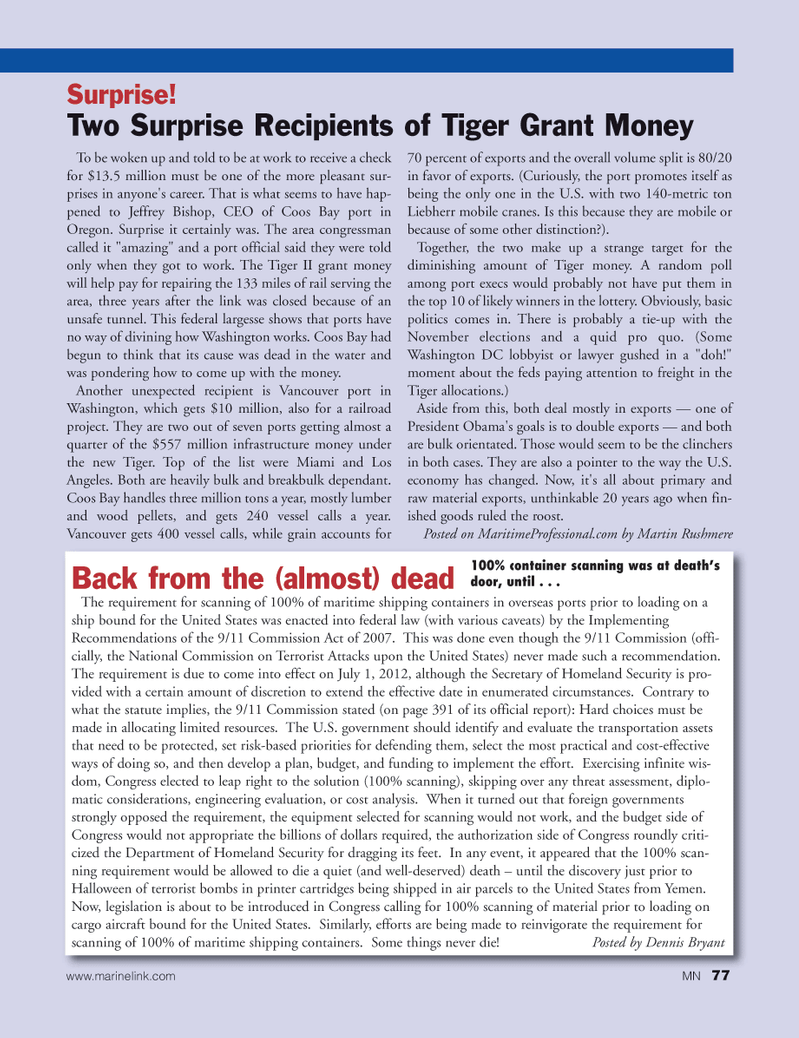
Page 77: of Marine News Magazine (November 2010)
Workboat Annual
Read this page in Pdf, Flash or Html5 edition of November 2010 Marine News Magazine
Back from the (almost) dead
The requirement for scanning of 100% of maritime shipping containers in overseas ports prior to loading on a ship bound for the United States was enacted into federal law (with various caveats) by the Implementing
Recommendations of the 9/11 Commission Act of 2007. This was done even though the 9/11 Commission (offi- cially, the National Commission on Terrorist Attacks upon the United States) never made such a recommendation.
The requirement is due to come into effect on July 1, 2012, although the Secretary of Homeland Security is pro- vided with a certain amount of discretion to extend the effective date in enumerated circumstances. Contrary to what the statute implies, the 9/11 Commission stated (on page 391 of its official report): Hard choices must be made in allocating limited resources. The U.S. government should identify and evaluate the transportation assets that need to be protected, set risk-based priorities for defending them, select the most practical and cost-effective ways of doing so, and then develop a plan, budget, and funding to implement the effort. Exercising infinite wis- dom, Congress elected to leap right to the solution (100% scanning), skipping over any threat assessment, diplo- matic considerations, engineering evaluation, or cost analysis. When it turned out that foreign governments strongly opposed the requirement, the equipment selected for scanning would not work, and the budget side of
Congress would not appropriate the billions of dollars required, the authorization side of Congress roundly criti- cized the Department of Homeland Security for dragging its feet. In any event, it appeared that the 100% scan- ning requirement would be allowed to die a quiet (and well-deserved) death – until the discovery just prior to
Halloween of terrorist bombs in printer cartridges being shipped in air parcels to the United States from Yemen.
Now, legislation is about to be introduced in Congress calling for 100% scanning of material prior to loading on cargo aircraft bound for the United States. Similarly, efforts are being made to reinvigorate the requirement for scanning of 100% of maritime shipping containers. Some things never die! Posted by Dennis Bryant
Surprise!
Two Surprise Recipients of Tiger Grant Money
To be woken up and told to be at work to receive a check for $13.5 million must be one of the more pleasant sur- prises in anyone's career. That is what seems to have hap- pened to Jeffrey Bishop, CEO of Coos Bay port in
Oregon. Surprise it certainly was. The area congressman called it "amazing" and a port official said they were told only when they got to work. The Tiger II grant money will help pay for repairing the 133 miles of rail serving the area, three years after the link was closed because of an unsafe tunnel. This federal largesse shows that ports have no way of divining how Washington works. Coos Bay had begun to think that its cause was dead in the water and was pondering how to come up with the money.
Another unexpected recipient is Vancouver port in
Washington, which gets $10 million, also for a railroad project. They are two out of seven ports getting almost a quarter of the $557 million infrastructure money under the new Tiger. Top of the list were Miami and Los
Angeles. Both are heavily bulk and breakbulk dependant.
Coos Bay handles three million tons a year, mostly lumber and wood pellets, and gets 240 vessel calls a year.
Vancouver gets 400 vessel calls, while grain accounts for 70 percent of exports and the overall volume split is 80/20 in favor of exports. (Curiously, the port promotes itself as being the only one in the U.S. with two 140-metric ton
Liebherr mobile cranes. Is this because they are mobile or because of some other distinction?).
Together, the two make up a strange target for the diminishing amount of Tiger money. A random poll among port execs would probably not have put them in the top 10 of likely winners in the lottery. Obviously, basic politics comes in. There is probably a tie-up with the
November elections and a quid pro quo. (Some
Washington DC lobbyist or lawyer gushed in a "doh!" moment about the feds paying attention to freight in the
Tiger allocations.)
Aside from this, both deal mostly in exports — one of
President Obama's goals is to double exports — and both are bulk orientated. Those would seem to be the clinchers in both cases. They are also a pointer to the way the U.S. economy has changed. Now, it's all about primary and raw material exports, unthinkable 20 years ago when fin- ished goods ruled the roost.
Posted on MaritimeProfessional.com by Martin Rushmere 100% container scanning was at death’s door, until . . . www.marinelink.com MN 77

 76
76

 78
78
